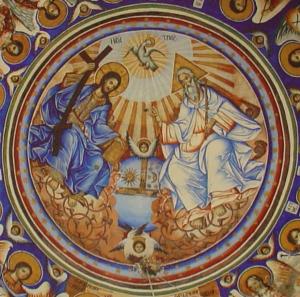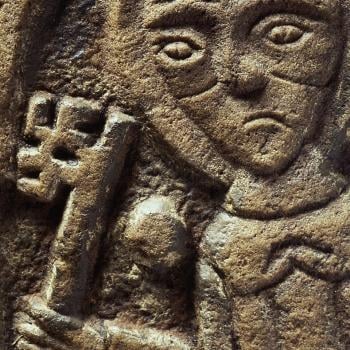
One of the saddest debates in Christian history is that over the inclusion and interpretation of the filioque clause in the Nicene Creed in the West. Orthodox believers stood (and continue to stand) on both sides of the debate. This is because, despite the different convention being employed, so long as the filioque was properly interpreted, the implication of the clause is perfectly sound and orthodox. However, when the charity which should keep Christians bonded together waned, political agendas arose, and the differences in conventions encouraged people to read what the other said with the worst possible interpretation instead of seeking how what they said could be compatible with what they believed. Sadly, this was the case when St. Photios, fighting for his own personal authority against St. Ignatius and the Pope of Rome, used an uncharitable reading of the filioque to undermine his opponents, because the West used the filioque in its recitation of the Nicene Creed.
Photios properly held many positions which lay behind his understanding of the Trinity. God is not composite, nor are the persons of the Godhead composite. This follows the basic principle of Divine Simplicity. The teaching of the Trinity must not be construed as teaching that the Godhead is composed of three parts. Likewise, the Father is the foundation for the other persons of the Trinity: the Father begets the Son and the Spirit proceeds from the Father. This is also something which those who accept the filioque, the procession of the Spirit from the Father and the Son, agree, because they also say that the Spirit proceeds from the Father. Finally, Photios believed that the teachings of the Fathers and Ecumenical Councils are fundamental, and so Christian theology of the Trinity must follow with what was said and taught before.
The problem Photios had with the filioque is that he did not believe that it was taught dogmatically by the Fathers before him (he begrudgingly accepts that some Western Fathers might have speculated on it), and that he thought that having the Spirit proceeding from the Father and the Son would give the Holy Spirit a double origin, making it composite in nature:
Some others recognize that the Son’s generation does not impair the indescribable simplicity of the Father. But since it is claimed that He proceeds from two persons, the Spirit is brought to a double cause, thereby obscuring the simplicity of the Most High. Does it not follow as an implication of this that the Spirit is therefore composite? How then is the Trinity simple? [1]
This, however, is a forced interpretation of the filioque. If his reading were correct, he would be right in saying the teaching of the filioque undermines the Trinity. However, such a hermeneutic would also undermine basic Trinitarian theology. If the procession from the Father and the Son means the Holy Spirit is composite in nature, then the Trinity having three persons means the Trinity is composite in nature. The persons of the Trinity, however, must not be seen as parts. If they are not parts, then the procession of the Spirit from the Father and the Son must not be seen as if coming from two parts leading to a composite person in the Holy Spirit. The filioque represents only one spiration, one procession; and it certainly is a procession from the Father; pointing out the Son also has a role in the procession does not remove the procession as being from the Father, nor does it add another cause or source to the procession. The persons of the Trinity are not divided in such a way that if two of them work together it means there are two causes to what they produce, even as when all three work together (as they do in the act of creation), that does not mean there are three causes for what they produce (such as creation). For the cause remains one, as God is one.
Thus, Photios is right in saying that there is only one spiration for the Holy Spirit, but he tries to read Western conventions used to describe that spiration in an absolute and literalistic fashion in order to justify his criticism of the filioque. He would not want others to do similarly with his reading of the spiration of the Holy Spirit. Indeed, he affirms that when talking about the procession of the Spirit, we are dealing with an ineffable mystery which transcends human reason (and therefore, human conventions):
But according to the myriads of voices who piously delivered the doctrine of the indescribable Godhead on high, the Spirit is of the essence-above-essence. His eternal, incorporeal procession is therefore beyond the powers of reason. [2]
This is something which he should have kept in mind when he tried to suggest the filioque makes the Holy Spirt the “son” of the Son, and the “Grandson” of the Father:
If the Son is begotten from the Father, and the Spirit proceeds from the Son, then how is it that this godless doctrine does not, according to its own line of reasoning, make the Spirit a grandson and thus drive away the terrors of theology into prolix and idle talk? [3]
The problem with this misinterpretation is simple, and one can be answered by reading theological discussions which came before Photios: procession is not begetting. This is why the Spirit, proceeding from the Father, is not seen as a second Son to the Father. If a procession of the Spirit from the Son means the Spirit is the son of the Son, then the Spirit would be a Son of the Father for proceeding from the Father. But this is not the case. The Fathers understood the mystery of the Trinity meant that the procession of the Spirit differs from generation, and once this is understood, many objections to the filioque shows themselves to be a forced misinterpretation which would also refute the position of those objecting to the filioque.
The procession of the Spirit from the Father and the Son is not meant to be some innovation, but rather, it is an attempt to understand the implications of the economic Trinity within the immanent Trinity. What is revealed in economy reveals something of the inner life of the Trinity. The Son revealed He would send the Spirit into the world after his ascension, and the filioque developed in the West as a way to understand the implications of this in the inner life of the Trinity. Likewise, the Father is also involved with the sending of the Spirit in the world. We do not have two causes for the sending of the Spirit into the world, nor two sendings of the Spirit into the world, but one. And so, with the filioque, we do not have a double-cause for the Spirit, but rather, a way for us to understand the Father and the Son have a unique relationship with the Spirit which differs from the Sonship of the Son.
St. Photios, like many saints before him (such as St. Jerome), was a highly educated man, but also one who let controversy sometimes get the best of him. He wanted to be right, but he thought that to be right, his opponents had to be wrong, and so he argued against his opponents using strawmen in order to justify himself. Sadly, did so because he wanted to find something he could use to undermine the authority of his opponents, and questioning their orthodoxy was the way he decided to do so. Recognizing this flaw should not lead us to question his sanctity. He is a saint, and a great one who has much to offer us if we look beyond his unhealthy disputes with others. And as such, we can recognize in him what he said of others saints who had discernable faults: “Though they were otherwise arrayed with the noblest reflections, they were human.” [4] Photios was human. Like St. Jerome, his faults did lead to great tragedy in the church, but also like Jerome, we can still see the holiness of God at work in him. Holy saints were not faultless, but rather, they were human like all of us, and so, recognizing their great faults, we can see through them the truth of the Gospel, where sinners not only can be saved, but rendered holy thanks to the work of Jesus Christ and the Holy Spirit in the world (instead of the having the impossible need to live perfect, blameless lives).
[1] Saint Photios, The Mystagogy of the Holy Spirit. Trans. Joseph P. Farrell (Brookline, MA: Holy Cross Orthodox Press), 60-61.
[2] Saint Photios, The Mystagogy of the Holy Spirit. 62.
[3] Saint Photios, The Mystagogy of the Holy Spirit, 88.
[4] Saint Photios, The Mystagogy of the Holy Spirit, 91.
Stay in touch! Like A Little Bit of Nothing on Facebook.
If you liked what you read, please consider sharing it with your friends and family!













